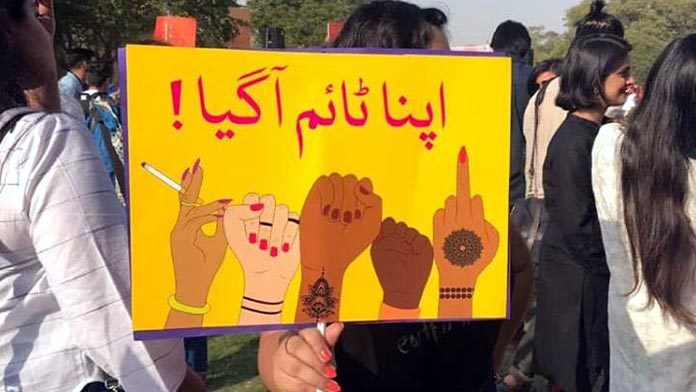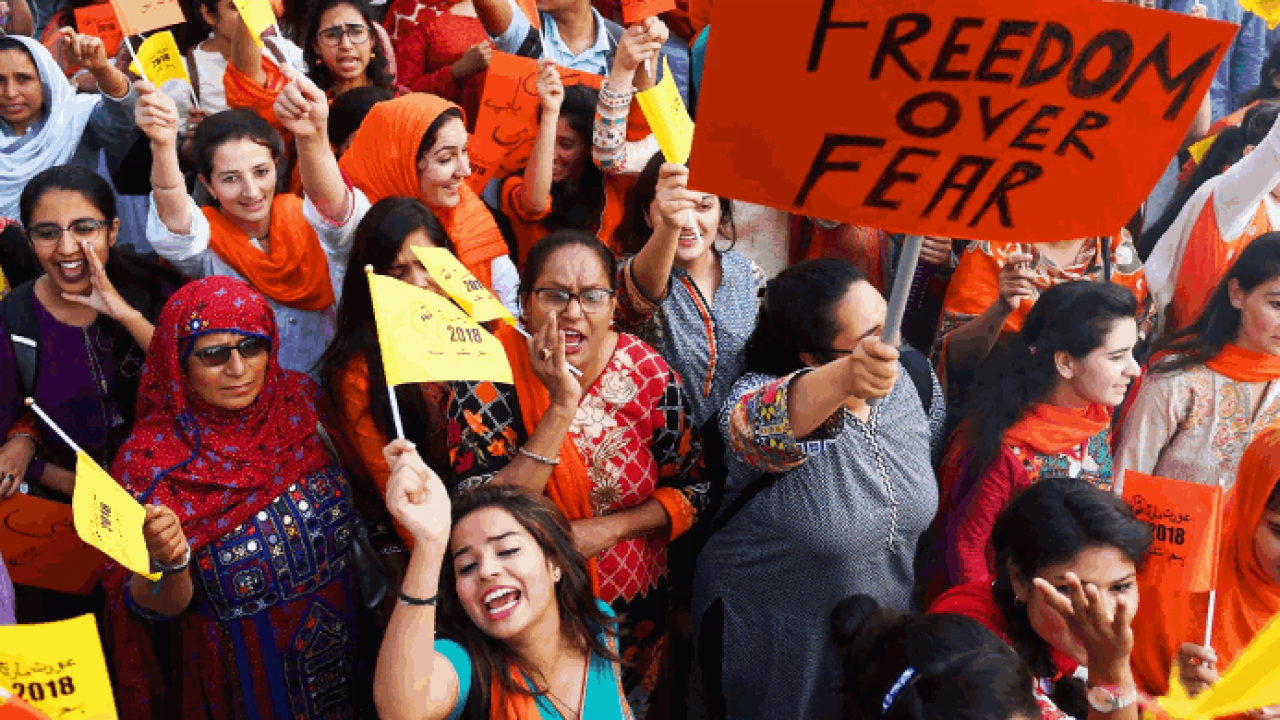Women taking to public spaces to express their discontent with the state and society is not unheard of. Each time they come out, and defy the boundaries set for them by the samaj (society), it is born out of the pure frustration, and anger that comes from years of being subjected to violence, oppression and objectification in the hands of the state, the army, big corporations, and even within our households – Black Lives Matter was founded by three black women (Alicia Garza, Patrisse Cullors and Opal Tometi), to start a conversation on police brutality against black women and men, to mainstream media ; the Gulabi Gang (Banda, Uttar Pradesh) led by Sampat Devi Pal was formed in response to the lack of police support in cases of domestic violence; Saudi Arabia saw the #Iammyownguardian movement, which called to abolish the guardian system; and most recently the nationwide protests in India, against the Citizenship Amendment Act (CAA) and the implementation of the National Register of Citizens (NRC). These movements were led by women who belong to communities that have been viewed by western feminism as having “inferior culture”; and are a testament to the fact that patriarchy is omnipresent. These women face obstacles ridden with complexities and they are aware of it. Given this context, I would like to draw your attention to the Aurat March, that is slated to take place on 8th March this year, in Pakistan.

What Is The Aurat March?
It all started in 2018, when ordinary women and feminist collectives, under the banner “Hum Aurtain” came together to organise a rally for International Women’s Day. This platform was an open call for women from all backgrounds, transgender people, and non-binary people to help bring about political action on women’s rights and gender justice.
In 2019, the march expanded to include Islamabad, Hyderabad, Quetta, Mardan, and Faislabad to its repertoire. It is endorsed by Lady Health Workers Association and organised by Hum Auratein (We the Women) in Lahore and Karachi. As it expanded, collectives like Women Democratic Front (WDF) and the Women Action Forum (WAF) have also helped organise marches across the country. In addition to these collectives, the march also included representatives from multiple women’s rights organisations.

Nighat Dad, the founder of Digital Rights Foundation and one of the organisers of the march in Lahore wrote,
“The agenda of the march was to demand resources and dignity for women, for transgender community, for religious minorities, and for those on the economic margins, but more importantly, to acknowledge that women’s emancipation is inherently linked with improvement of all mistreated groups and minorities”.
The protests follow a theme each year. In 2018, it was “Equality”, and in 2019, “Sisterhood and Solidarity”.
History
Tracing the trajectory of the women’s movement/feminist movement in Pakistan would have us go all the way to pre-partition times. Women’s consciousness of their own subjugation and the desire for personal and political emancipation germinated in the context of religious and nationalist movements. The colonial period also laid the foundation for the divide between the “traditional private” and the “secular public”. Pakistan, post-partition, saw a fledgling Women’s Movement that could barely challenge the religious lobby and the clergy.

The Women’s Voluntary Service (WVS) and All-Pakistan Women’s Association (APWA) largely undertook welfare work and concerned themselves with social-upliftment of women, refugees etc. Such work was seen as an extension of the care work that women already did, hardly saw any resistance. APWA’s relationship with the state helped pass the Muslim Family Laws Ordinance (1961), which gave women few rights with regard to marriage, custody of children, divorce, registration of marriages and divorce. Larger questions of democracy and justice were overlooked in exchange for a few rights.
Under General Zia’s regime, collectives like Women’s Action Forum (WAF) were forced to take up sloganeering, and demonstrations to resist the state machinery and its “reconstruction of the legal system, and institutionalisation of discrimination of women”. This battle put the women’s movement in the public sphere, while matters of the body and sexuality were only talked about in private conversations. The Aurat March seems to have brought with it, a new phase of feminism; a feminism that asserts that the personal, is in fact political and the patriarchal divide between the public and the private is false.
Manifesto
The core principles of the march dictate that it remain anonymous and diverse, and that it does not accept funding from NGOs or corporations. It demands recognition and reparations along the following concerns:
- Economic Justice, including the implementation of the Sexual Harassment Against Women in the Workplace 2010, the recognition of women’s contribution to the care economy as unpaid labour, implementation of labour rights for women, and gender and sexual minorities,
- Environmental Justice, including access to safe drinking water and air, protection of Animal Rights and Wildlife and women’s participation in the production of cash crops
- A total and immediate end to gender based violence against women, all genders and sexual minorities both offline and online
- Accountability and restorative justice against violence particularly in Federally Administered Tribal Areas, Balochistan and Gilgit- Baltistan, and other areas where women and vulnerable populations have trouble accessing justice
- An end to and accountability for police brutality
- End to enforced disappearances and due process to those who have been disappeared
- Inclusion of differently-abled persons, and those with less visible disabilities and mental illnesses in public spaces, equal access to and protection in public spaces and institutions for transgender persons
- Equal access to quality reproductive and sexual health services for women, all genders and sexual minorities,
- Reformation of personal laws of religious minorities, by eliminating discriminatory provisions
- Denunciation of policies of mass destruction, militarisation and warmongering.
The Use of Language To Subvert Patriarchy & The Backlash
To begin with, the usage of the word “Aurat” is a nod to Southasian activists and feminists and their attempt to communicate ideas of gender equality in regional languages. With the Aurat March, terms like “pidar-shahi” (patriarchy) have been widely circulated, thereby developing a language with which to communicate ideas of gender inequality. The Aurat March, has also used language to subvert patriarchy, by taking slogans that attack deeply entrenched relations of power within the household, and talk about demands that they had in their personal lives, with regard to their bodies and their sexuality.
Also read: Meet Marvia Malik: The First Trans Woman News Reporter Of Pakistan
These slogans ranged from the popular “Akeli Awara Azaad” to “Khud Khana Garam Kar Lo”, “Mera Jism, Meri Marzi”, “Khana main garam karoongi, tum bistar khud garam kar lo” and so on. Some posters also had the saying “men of quality will never be afraid of equality”, and “if you like the headscarf so much, tie it around your eyes”, and yet another one of a girl sitting with her legs spread out, and the slogan “Lo baith gayi sahi se”.

As expected, the Aurat March sparked outrage from both conservative and like-minded circles. While there was very little chatter about the manifesto itself, most of the criticism targeted the posters and slogans featured at the march. Many were of the opinion that the marchers were “vulgar opportunists” who had compromised traditional Islamic values, in a Muslim majority country and had cheapened a legitimate fight for rights with “liberal”, “anti-Islamic” agenda. While this is not the first time that women have attempted to reclaim public spaces in Pakistan, it was arguably one of the loudest, and politically boldest cry of frustration that a collective of women had let out.
It attempted to be inclusive and intersectional and most importantly, it brought to light demands that had been swept aside as “private matters” under the moniker “personal is not political”. This is the first bone of contention that the public seems to have with the Aurat March. Such a conversation regarding sex and sexuality will require confronting the “male sexual and class privileges across institutions”, and the “demand for sexual equality will require strategies that fall outside islamic rights”. The second one would be that, it focused solely on personal freedom such as the right to dress, mobility, against sexual harassment etc., but did not connect to economic or legal challenges at the state level.
8th March 2020
Despite the criticism, the online trolling, threats to rape and sexual harassment, it looks as though the ball has been set in motion for the march in 2020. According to make-up artisit Leena Ghani, the theme for 2020, shall be “Khudmukhtari (autonomy) and Violence (both sexual and economic)”. Artist Shehzil Malik posted a call on social media for poster design submissions for the Aurat March slated to take place on 8 March 2020. An Urdu version of the Chilean feminist anthem “Un Violador en tu Camino” – a Rapist in Your Path had also been performed in Karachi. In performing this anthem, the organisers of the march have asked women and allies to join them on 8th March.
Also read: Hell Hath No Fury Like Men Scorned Over Aurat March In Pakistan
However, trouble already seems to be brewing for the marchers in the form of a petition filed by the Judicial Activism Council Chairman to stop the Aurat March. This was fortunately rejected by the High Court on the grounds that “freedom of expression cannot be banned”. Marchers had also put up posters made by volunteers at Hussain Chowk, Lahore, to voice concerns of women in society, which was promptly taken down by a mob, that was uncomfortable with the display. Given today’s political climate, and the retaliation the marchers have witnessed and experienced, the ability to carry out an Aurat March 2020, would be a big (albeit small) win for women everywhere. I will be waiting with bated breath.
Featured Image Source: Daily Times
About the author(s)
Krishna has a masters degree in Development Studies from Azim Premji University, and hopes to establish a career in psychology and counselling. She currently resides in Kochi and is taking time out to recharge - physically, mentally and intellectually. Any suggestion that will aid the recharge process will be received with gratitude and excitement.




